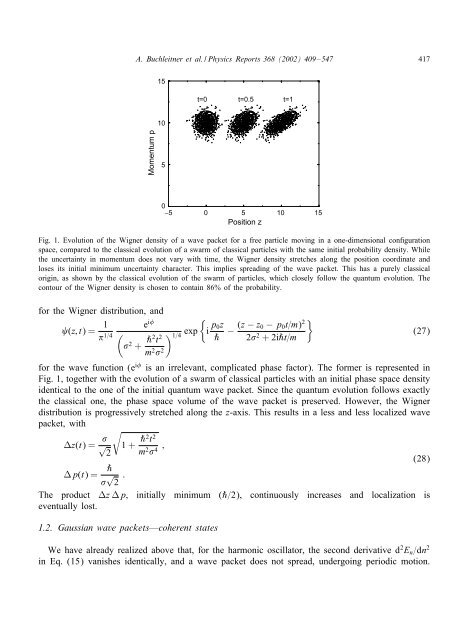Non-dispersive wave packets in periodically driven quantum systems
Non-dispersive wave packets in periodically driven quantum systems
Non-dispersive wave packets in periodically driven quantum systems
You also want an ePaper? Increase the reach of your titles
YUMPU automatically turns print PDFs into web optimized ePapers that Google loves.
A. Buchleitner et al. / Physics Reports 368 (2002) 409–547 417<br />
Momentum p<br />
15<br />
10<br />
5<br />
t=0 t=0.5 t=1<br />
0<br />
−5 0 5<br />
Position z<br />
10 15<br />
Fig. 1. Evolution of the Wigner density of a <strong>wave</strong> packet for a free particle mov<strong>in</strong>g <strong>in</strong> a one-dimensional con guration<br />
space, compared to the classical evolution of a swarm of classical particles with the same <strong>in</strong>itial probability density. While<br />
the uncerta<strong>in</strong>ty <strong>in</strong> momentum does not vary with time, the Wigner density stretches along the position coord<strong>in</strong>ate and<br />
loses its <strong>in</strong>itial m<strong>in</strong>imum uncerta<strong>in</strong>ty character. This implies spread<strong>in</strong>g of the <strong>wave</strong> packet. This has a purely classical<br />
orig<strong>in</strong>, as shown by the classical evolution of the swarm of particles, which closely follow the <strong>quantum</strong> evolution. The<br />
contour of the Wigner density is chosen to conta<strong>in</strong> 86% of the probability.<br />
for the Wigner distribution, and<br />
(z; t)= 1<br />
1=4<br />
<br />
ei ˝ 2 + 2t2 <br />
exp i 1=4<br />
m2 2<br />
p0z<br />
˝ − (z − z0 − p0t=m) 2<br />
2 2 <br />
+2i˝t=m<br />
for the <strong>wave</strong> function (ei is an irrelevant, complicated phase factor). The former is represented <strong>in</strong><br />
Fig. 1, together with the evolution of a swarm of classical particles with an <strong>in</strong>itial phase space density<br />
identical to the one of the <strong>in</strong>itial <strong>quantum</strong> <strong>wave</strong> packet. S<strong>in</strong>ce the <strong>quantum</strong> evolution follows exactly<br />
the classical one, the phase space volume of the <strong>wave</strong> packet is preserved. However, the Wigner<br />
distribution is progressively stretched along the z-axis. This results <strong>in</strong> a less and less localized <strong>wave</strong><br />
packet, with<br />
z(t)=√ 2<br />
<br />
p(t)= ˝ √ 2 :<br />
1+ ˝2t2 ;<br />
m2 4<br />
The product z p, <strong>in</strong>itially m<strong>in</strong>imum (˝=2), cont<strong>in</strong>uously <strong>in</strong>creases and localization is<br />
eventually lost.<br />
1.2. Gaussian <strong>wave</strong> <strong>packets</strong>—coherent states<br />
We have already realized above that, for the harmonic oscillator, the second derivative d 2 En=dn 2<br />
<strong>in</strong> Eq. (15) vanishes identically, and a <strong>wave</strong> packet does not spread, undergo<strong>in</strong>g periodic motion.<br />
(27)<br />
(28)











